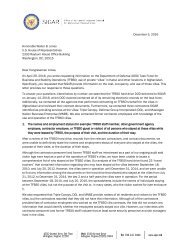SIGAR
2016-04-30qr
2016-04-30qr
You also want an ePaper? Increase the reach of your titles
YUMPU automatically turns print PDFs into web optimized ePapers that Google loves.
Security: The eroding bedrock<br />
the course of several quarters, the International Security Assistance Force<br />
(ISAF) told <strong>SIGAR</strong> that ANDSF personnel numbers sometimes included<br />
civilians and sometimes did not. Moreover, large quarterly changes in the<br />
numbers of Afghan Army personnel at the headquarters level, as well as discrepancies<br />
in the data, further raised concerns. A January 2015 <strong>SIGAR</strong> audit<br />
found that more than $300 million in annual, U.S.-funded salary payments to<br />
the ANP were based on data that were only partially verified or reconciled. 35<br />
In an April 2015 audit, <strong>SIGAR</strong> found that there was still no assurance that<br />
ANA personnel and payroll data—tracked and reported by the Ministry of<br />
Defense and the Afghan Army—are accurate. 36 U.S. and Coalition officials<br />
are not present during the attendance-taking process, and command officials<br />
told <strong>SIGAR</strong> that they have limited knowledge of or influence over it.<br />
Having reasonably accurate reports on ANDSF strength is important<br />
for protecting the U.S. funds that support them, for judging their aggregate<br />
capabilities, and for calibrating the details of the RS train-advise-assist mission.<br />
Unfortunately, that knowledge remains elusive.<br />
Capability Assessments Are Unreliable<br />
<strong>SIGAR</strong> is also concerned that measures of ANDSF capabilities and effectiveness<br />
have never been very reliable and are getting worse. The RS<br />
mission’s predecessor, ISAF, used several assessment tools to measure<br />
ANDSF unit capability in areas including leadership, command and control,<br />
equipment, and attrition. These assessments are important gauges for U.S.<br />
and Afghan stakeholders in security reconstruction. Over the years, however,<br />
detail and quality of these assessments have declined.<br />
For example, a 2010 <strong>SIGAR</strong> audit found that top-rated ANDSF units—<br />
those deemed capable of operating independently—could not sustain the<br />
gains they had made. The rating system overstated their operational capabilities<br />
and actually created disincentives for ANDSF improvement. <strong>SIGAR</strong><br />
auditors found significant levels of regression, or backsliding, in the capability<br />
levels of army and police units, due, in part, to the fact that once a unit<br />
achieved a top rating, Coalition forces withdrew assistance such as force<br />
protection, supplies, and expertise. 37<br />
Following <strong>SIGAR</strong>’s audit, ISAF Joint Command (IJC) changed its system<br />
for rating the ANDSF. The previous system’s top rating was “fully capable,”<br />
but the new system’s top rating changed over time from “effective with<br />
advisors” to “independent with advisors.” 38 Unfortunately each new system<br />
seemed to provide less detail than the one before—and lower thresholds for<br />
determining the success of Afghan units.<br />
In July 2012, the GAO raised concerns that the change of the title of the<br />
highest rating level from “independent” to “independent with advisors”<br />
was, in part, responsible for an increase in the number of ANDSF units<br />
rated at the highest level—suggesting that achieving independence proved<br />
10<br />
Special inspector general I Afghanistan reconstruction




